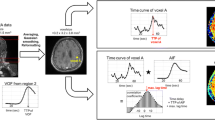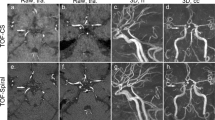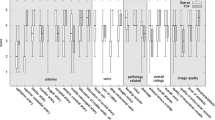Abstract
Introduction: For three-dimensional (3D) imaging with magnetic resonance angiography (MRA) of the cerebral and cervical circulation, both a high temporal and a high spatial resolution with isovolumetric datasets are of interest. In an initial evaluation, we analyzed the potential of contrast-enhanced (CE) time-resolved 3D-MRA as an adjunct for neurovascular MR imaging. Methods: In ten patients with various cerebrovascular disorders and vascularized tumors in the cervical circulation, high-speed MR acquisition using parallel imaging with the GeneRalized Autocalibrating Partially Parallel Acquisitions (GRAPPA) algorithm on a 1.5-T system with a temporal resolution of 1.5 s per dataset and a nearly isovolumetric spatial resolution was applied. The results were assessed and compared with those from conventional MRA and digital subtraction angiography (DSA). Results: CE time-resolved 3D-MRA enabled the visualization and characterization of high-flow arteriovenous shunts in cases of vascular malformations or hypervascularized tumors. In steno-occlusive disease, the method provided valuable additional information about altered vessel perfusion compared to standard MRA techniques such as time-of-flight (TOF) MRA. The use of a nearly isovolumetric voxel size allowed a free-form interrogation of 3D datasets. Its comparatively low spatial resolution was found to be the major limitation. Conclusion: In this preliminary analysis, CE time-resolved 3D-MRA was revealed to be a promising complementary MRA sequence that enabled the visualization of contrast flow dynamics in various types of neurovascular disorders and vascularized cervical tumors.





Similar content being viewed by others
References
Cloft HJ, Joseph GJ, Dion JE (1999) Risk of cerebral angiography in patients with subarachnoid hemorrhage, cerebral aneurysm, and arteriovenous malformation: a meta-analysis. Stroke 30:317–320
Wang Y, Johnston DL, Breen JF et al (1996) Dynamic MR digital subtraction angiography using contrast enhancement, fast data acquisition, and complex subtraction. Magn Reson Med 36:551–556
Hennig J, Scheffler K, Laubenberger J, Strecker R (1997) Time-resolved projection angiography after bolus injection of contrast agent. Magn Reson Med 37:145–341
Wetzel SG, Bilecen D, Lyrer P et al (2000) Cerebral dural arteriovenous fistulas: detection by dynamic MR projection angiography. AJR Am J Roentgenol 174:1293–1295
Aoki S, Yoshikawa T, Hori M et al (2000) MR digital subtraction angiography for the assessment of cranial arteriovenous malformations and fistulas. AJR Am J Roentgenol 175:451–453
Griswold MA, Jakob PM, Heidemann RM et al (2002) Generalized autocalibrating partially parallel acquisitions (GRAPPA). Magn Reson Med 47(6):1202–1210
Pruessmann KP, Weiger M, Scheidegger MB, Boesiger P (1999) SENSE: sensitivity encoding for fast MRI. Magn Reson Med 42(5):952–962
Wetzel SG, Law M, Lee VS, Cha S, Johnson G, Nelson K (2003) Imaging of the intracranial venous system with a contrast-enhanced volumetric interpolated examination. Eur Radiol 13(5):1010–1018
Cognard C, Gobin YP, Pierot L et al (1995) Cerebral dural arteriovenous fistulas: clinical and angiographic correlation with a revised classification of venous drainage. Radiology 194:671–680
Klisch J, Strecker R, Hennig J, Schumacher M (2000) Time-resolved projection MRA: clinical application in intracranial vascular malformations. Neuroradiology 42:104–107
Coley SC, Romanowski CA, Hodgson TJ, Griffiths PD (2002) Dural arteriovenous fistulae: non-invasive diagnosis with dynamic MR digital subtraction angiography. AJNR Am J Neuroradiol 23:404–407
Noguchi K, Melhem ER, Kanazawa T, Kubo M, Kuwayama N, Seto H (2004) Intracranial dural arteriovenous fistulas: evaluation with combined 3D time-of-flight MR angiography and MR digital subtraction angiography. AJR Am J Roentgenol 182:183–190
Liang L, Korogi Y, Sugahara T et al (2001) Evaluation of the intracranial dural sinuses with a 3D contrast-enhanced MP-RAGE sequence: prospective comparison with 2D-TOF MR venography and digital subtraction angiography. AJNR Am J Neuroradiol 22:481–492
Ziyeh S, Strecker R, Berlis A, Weber J, Klisch J, Mader I (2005) Dynamic 3D MR angiography of intra- and extracranial vascular malformations at 3T: a technical note. AJNR Am J Neuroradiol 26:630–634
Tsuchiya K, Aoki C, Fujikaw A, Hachiya J (2004) Three-dimensional MR digital subtraction angiography using parallel imaging and keyhole data sampling in cerebrovascular diseases: initial experience. Eur Radiol 14:1494–1497
Author information
Authors and Affiliations
Corresponding author
Rights and permissions
About this article
Cite this article
Meckel, S., Mekle, R., Taschner, C. et al. Time-resolved 3D contrast-enhanced MRA with GRAPPA on a 1.5-T system for imaging of craniocervical vascular disease: initial experience. Neuroradiology 48, 291–299 (2006). https://doi.org/10.1007/s00234-006-0052-9
Received:
Accepted:
Published:
Issue Date:
DOI: https://doi.org/10.1007/s00234-006-0052-9




